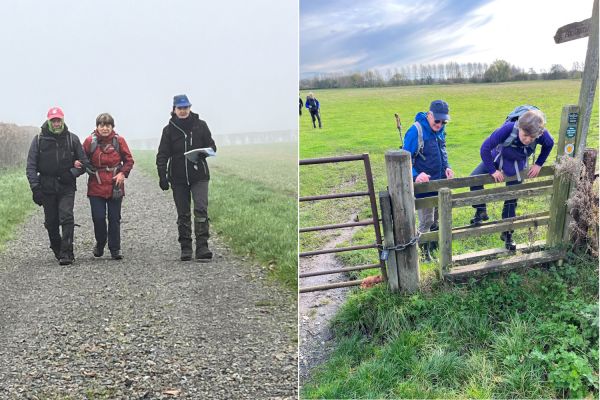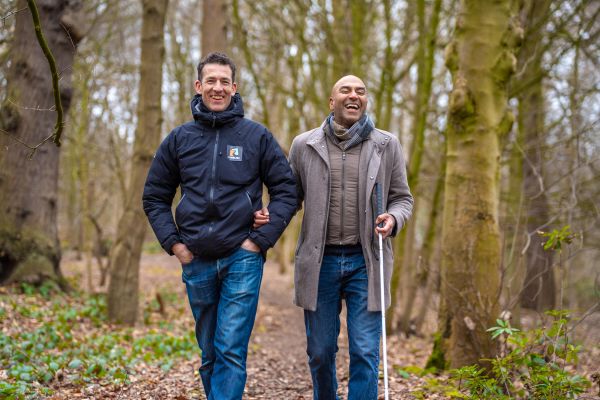Towpath walks: the answer to one walker’s failing eyesight
Writer and Ramblers member Peter Clarke shares how he is enjoying canal-side towpath walks

A passion for long distance walking
Four years ago, I celebrated my eightieth birthday by walking the Pennine Way, 250 miles, north to south, along the spine of England. I walked with my son, Nat, and we took eighteen days. Although I had been in training for this kind of walk for 60 years and more, I found it tough going. The central section was relatively easy, a high moorland path paved with flagstones. But the first four or five days were hard, through the Cheviots and the fearsome Cross Fell. And the last day over Kinder Scout in Derbyshire was challenging.
The impact of failing eyesight
But climbing British mountains and fell-walking is no longer the fun it has been for decades. Failing eyesight means that distant views from mountain tops or ridges, no longer give a thrill. But I have found a wonderful alternative: exploring the canals by walking along towpaths.
Canal towpath walks
I started ten years ago by walking from Somerset up to London along the Kennet and Avon canal. In more recent years I have walked along other canals including the Grand Union Canal from London to Birmingham.
Most recently Nat and I have walked the towpath from Liverpool to Leeds, 127 miles of hugely varied landscapes. It takes in dockland Liverpool; south Lancashire farmlands; post-industrial urbanscapes of Wigan, Blackburn, Accrington and Burnley; the gentle slopes of the Pennines; the statue of Fred Trueman in Skipton; the towns of Bingley, Saltaire and Shipley and the suburbs of the city of Leeds. For the final quarter of a mile, the canal snakes through 21st century glass-plated giant skyscrapers. Our walk passed the monuments of two centuries of social history.
Long, gentle, safe canal-side walks
On a canal-side walk, every few miles the countryside changes. The mind and imagination are constantly stimulated. But above all, the aging body is not strained as it is by climbing a mountain or walking a long trail. No calves aching from tackling gradients. The steepest climbs are the slopes by a series of locks – spectacular as at Foxton in Leicestershire, or beautiful as at Wigan. It is hard to get lost on a canal walk. The towpaths are clear, and the only danger is when there is a junction of canals.
There is a community of canal users, both on the towpath or on the water. Much freight is still transported by canal. They are also social venues. The long-distance walkers are in a small minority, but dog-walkers and joggers always respond to a “Hi there”.
And there are the long narrow boats. As they glide past the walker, or (more rarely) as we pass the boats, there is always a comradely exchange. Or even a chat. I once fell into a conversation with one narrow boatsman.
“What’s the name of your dog?” I asked.
“Deefer,” he answered.
“Deefer? That’s a strange name.”
“D for Dog.”
The sounds and silence of the towpath
I walked the canal from London to Birmingham in a cold January. Ice covered the surface of the canal. As a narrow boat ripped through the ice, I listened to the din it made, like the continuous sound of a broken window.
For me, the best moments on the towpath are when it is far from roads or railway lines. Silence? Well, not exactly. I pause, and listen to birdsong, the wind in the trees, insects buzzing. Perfection. And it’s all free!
Peter’s latest book, The Men of 1924, about the first Labour government is being published in September 2023. Photographs are by Nathaniel Clark.

Walking is about more than what you can see
Ramblers member Marika has been blind since childhood, but that hasn’t stopped her from enjoying walking.

10 tips on guiding a blind or partially sighted person
Guiding a blind or partially sighted walking companion can be a hugely rewarding experience for both of you.

An introduction to Amar Latif, President of the Ramblers
Despite losing 95% of his vision by the age of 18, Amar hasn’t let sight loss be a barrier to walking outdoors or to travelling around the world.
